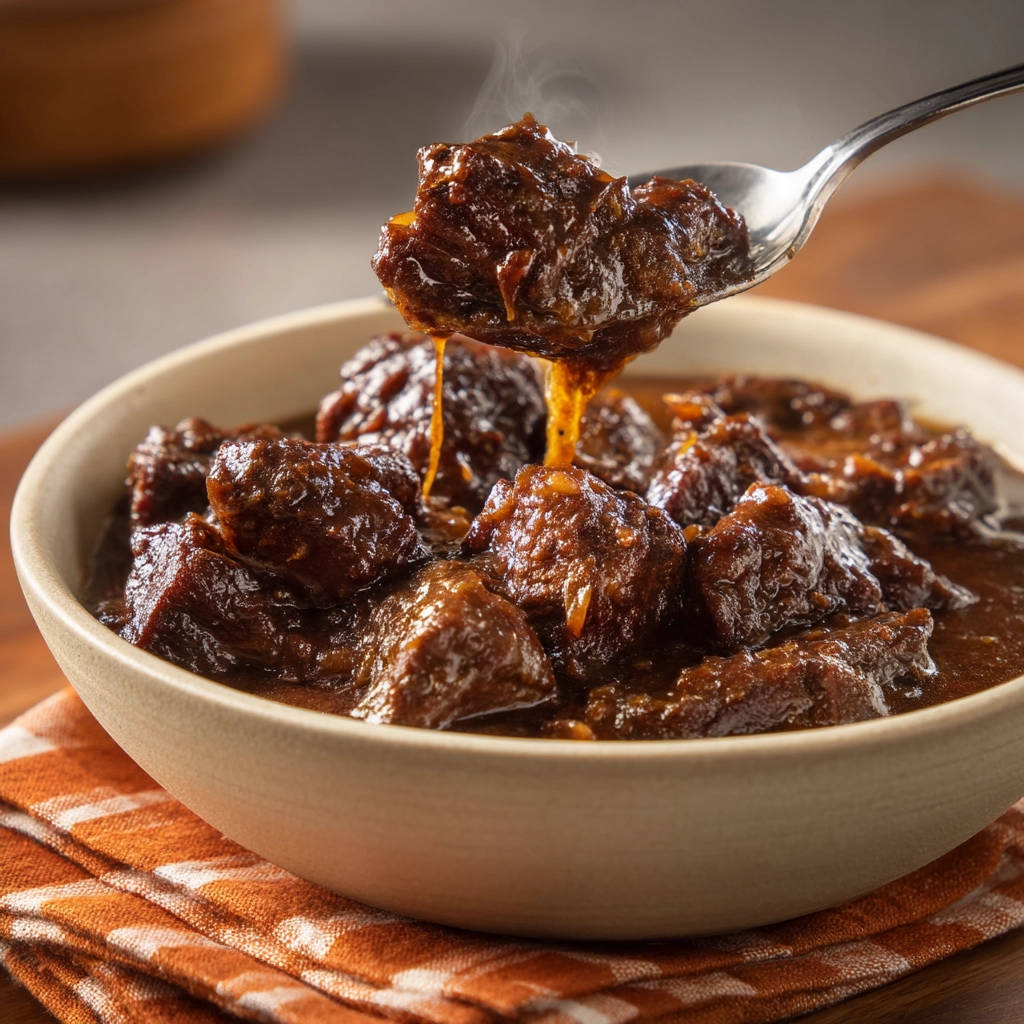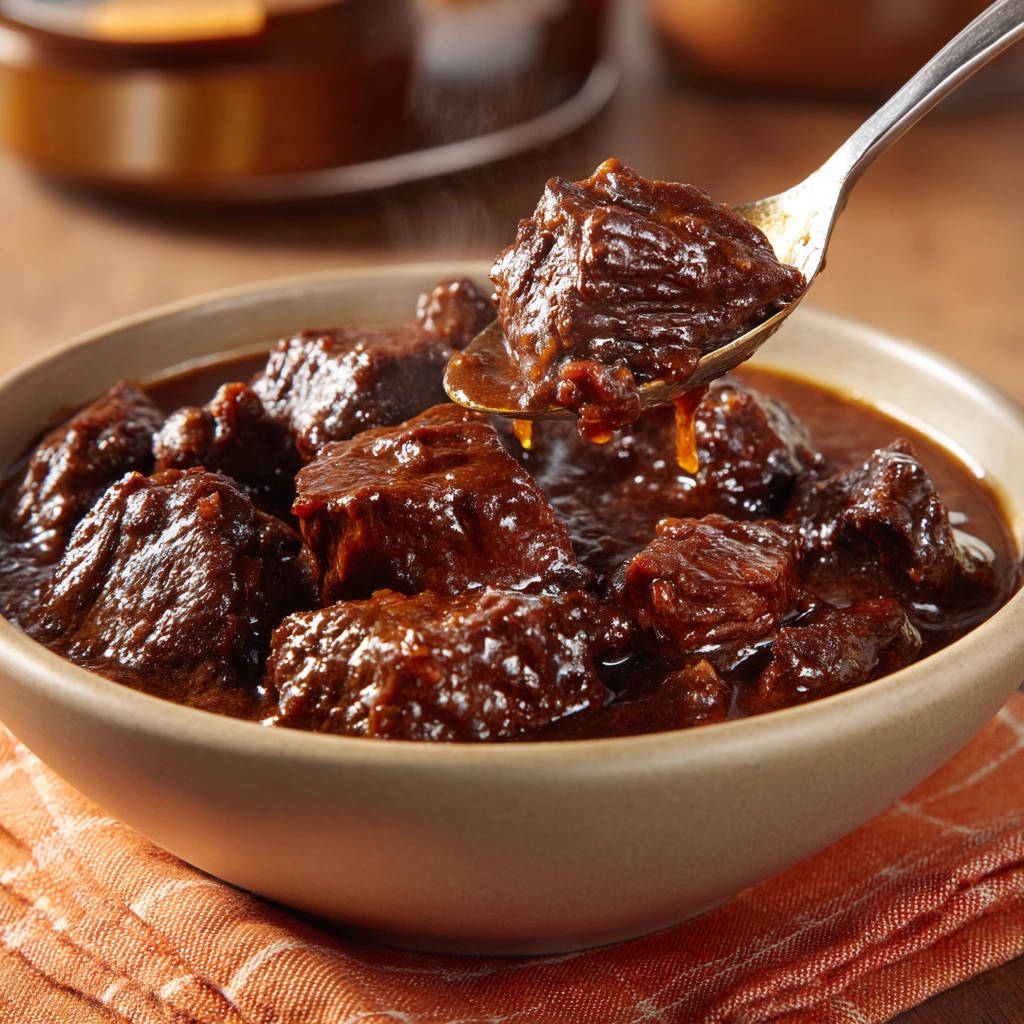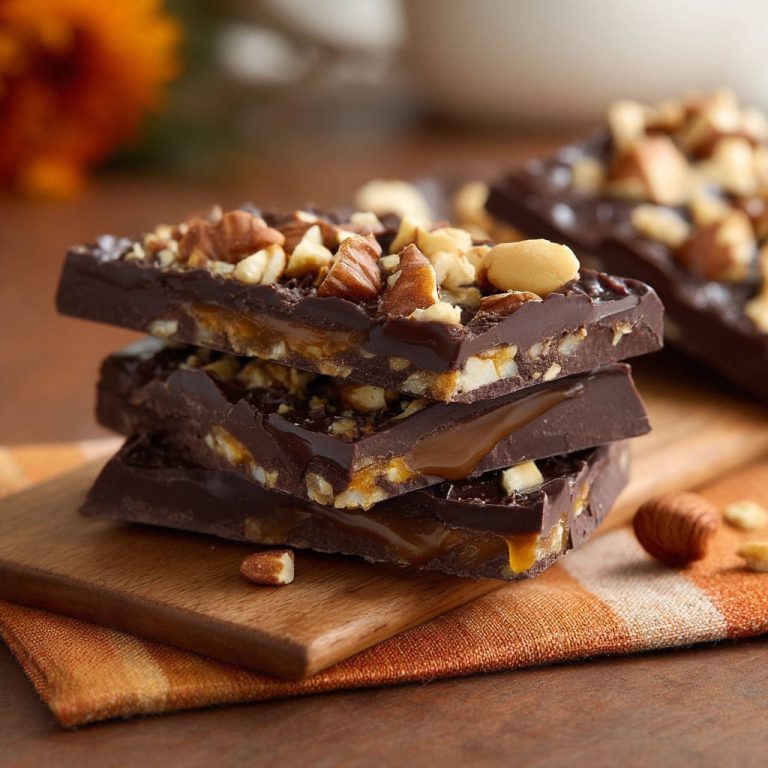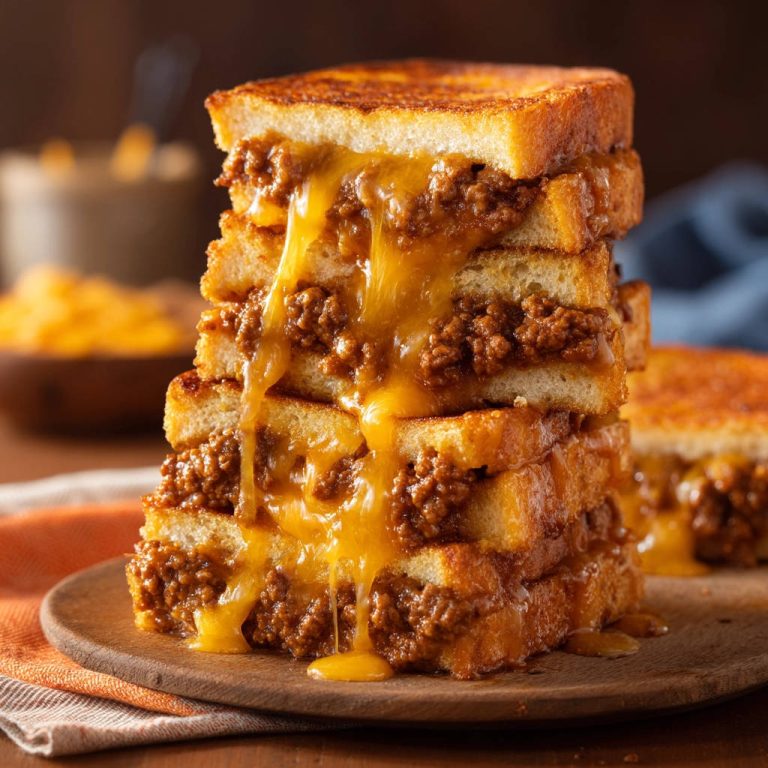There’s a special kind of comfort that only a truly classic beef stew can deliver. Imagine rich, savory broth, tender chunks of beef that melt in your mouth, and simple, honest flavors warming you from the inside out. It’s the kind of meal that feels like a hug on a chilly evening.
But let’s be honest, haven’t we all experienced the disappointment of spending time and effort making a beautiful beef stew, only to find the meat is frustratingly tough and chewy? It used to happen to me more often than I care to admit! For years, achieving that perfect, fall-apart tender beef in a stew felt like some kind of culinary magic trick I just couldn’t master.
Well, I’m here to tell you, the secret isn’t magic at all. It’s actually quite simple, and once you understand it, you’ll never make tough beef stew again! This recipe focuses on that absolute key to meltingly tender beef every single time, turning a potentially disappointing meal into a guaranteed comfort food winner.
Get ready to master the art of hearty beef stew. It’s easier than you think, and the delicious reward is absolutely worth it.
Why You’ll Love This Hearty Beef Stew Recipe
Beyond just avoiding tough meat, this hearty beef stew offers so many reasons to become a staple in your kitchen. It’s a recipe designed for maximum flavor and minimal fuss once it’s simmering away.
- Melt-in-Your-Mouth Beef: This is the star attraction! We focus on the technique that ensures your beef chuck roast transforms into buttery, tender pieces.
- Rich, Deep Flavor: Browning the meat properly and deglazing the pot builds incredible depth right from the start. The simple aromatics and herbs add layers of classic savory taste.
- Incredibly Comforting: This is the definition of stick-to-your-ribs comfort food. Perfect for cold weather or any time you need a warm, satisfying meal.
- Simple Ingredients: You won’t find a long, complicated list here. Just basic, accessible ingredients that come together beautifully.
- Mostly Hands-Off Cooking: After a bit of initial prep and browning, the magic happens slowly on the stovetop, freeing you up to do other things.
- Great for Meal Prep: Stew often tastes even better the next day as the flavors meld. It reheats wonderfully.
Gathering Your Ingredients for This Hearty Beef Stew
The beauty of a classic hearty beef stew lies in the simplicity and quality of its components. Each ingredient plays a specific role in creating the rich flavor and perfect texture we’re aiming for. Think of these as the building blocks of comfort.
Our foundation, of course, is the beef. We specify using 2 pounds of beef chuck roast cut into roughly 1-inch cubes. Chuck roast is the ideal cut for stewing because it contains a good amount of connective tissue. While this tissue makes the meat tough initially, given enough low, slow cooking time, it breaks down into gelatin, adding luxurious richness to the sauce and making the beef incredibly tender. Don’t be tempted to use leaner cuts like sirloin or round; they won’t achieve that signature fall-apart tenderness.
To help us achieve a beautiful brown crust on the beef and to contribute to the thickness of our stew’s sauce later on, we’ll use 2 tablespoons of all-purpose flour. This gets tossed with the meat along with simple seasonings: 1 teaspoon of salt and 1/2 teaspoon of black pepper. These measurements are a starting point; you’ll adjust seasoning at the end.
For cooking, we need a good fat. 2 tablespoons of olive oil provide enough to generously coat the bottom of your pot for searing. You could also use another high-smoke-point oil if you prefer.
The aromatic base of our stew is classic and essential for depth of flavor. We’ll use 1 large onion, chopped, cooked until softened and sweet, and 3 cloves of garlic, minced, added at the end of the onion cooking for just a minute until fragrant. Fresh is always best for these!
The main liquid component is 4 cups of beef broth. Good quality beef broth is crucial here as it provides the savory foundation for the sauce. Look for low-sodium options if you want more control over the final saltiness. A little bit of concentrated flavor comes from 1 tablespoon of tomato paste. Tomato paste adds a subtle richness and acidity that balances the other savory elements without making the stew taste overtly tomatoey.
Finally, for those quintessential stew flavors, we add a bay leaf and 1 teaspoon of dried thyme. These dried herbs release their flavor gradually over the long cooking time, infusing the entire stew with warmth and depth.
Here’s a quick list of what you’ll need:
- 2 pounds beef chuck roast, cut into 1-inch cubes
- 2 tablespoons all-purpose flour
- 1 teaspoon salt
- 1/2 teaspoon black pepper
- 2 tablespoons olive oil
- 1 large onion, chopped
- 3 cloves garlic, minced
- 4 cups beef broth
- 1 tablespoon tomato paste
- 1 bay leaf
- 1 teaspoon dried thyme
Crafting Your Hearty Beef Stew: Step-by-Step
Making this hearty beef stew is a process of building layers of flavor, culminating in that perfect, tender result. Don’t rush the early steps; they are crucial for the final taste and texture.
-
Prepare the Beef for Searing: Begin by preparing your beef cubes. This is a step that makes a significant difference in the browning process. Pat the beef cubes thoroughly dry using paper towels. Excess moisture on the surface of the meat will cause it to steam rather than sear, preventing that crucial browning we want. Don’t skip this!
-
Coat the Beef: In a medium-sized bowl, take your dried beef cubes and toss them with the all-purpose flour, salt, and black pepper. Make sure each piece is lightly and evenly coated. The flour helps create a nice crust when searing and will also act as a thickener for the stew’s sauce later on, giving it body and richness.
-
Sear the Beef for Flavor: Heat the olive oil in a large, heavy-bottomed pot or Dutch oven over medium-high heat. A heavy pot retains heat well, which is essential for achieving a good sear. Once the oil is hot and shimmering, add about half of the floured beef cubes to the pot. Arrange them in a single layer. The key here is to brown the meat well on all sides, which usually takes about 5-7 minutes per batch. You’re looking for a deep brown crust. This browning step, known as the Maillard reaction, creates incredible depth of flavor. Don’t overcrowd the pot; if you add too much meat at once, the temperature will drop, and the meat will steam instead of browning. Remove the browned beef to a plate and repeat with the remaining beef, adding a little more oil if needed. Leave those browned bits stuck to the bottom of the pot – they are flavor gold!
-
Sauté the Aromatics: Reduce the heat in the pot to medium. Add the chopped onion to the pot. Cook, stirring occasionally and scraping up some of those browned bits from the bottom, until the onion has softened and become translucent, which should take another 5-7 minutes. Then, add the minced garlic and cook for just 1 minute more. Be careful not to burn the garlic, as it can turn bitter; you just want to cook it until it’s fragrant.
-
Build the Liquid Base: Pour in the beef broth. Use a wooden spoon or spatula to scrape the bottom of the pot vigorously, loosening all those delicious browned bits (the “fond”) that stuck from searing the beef. These bits dissolve into the broth and are packed with flavor. Stir in the tomato paste until it’s fully incorporated into the liquid. Add the bay leaf and dried thyme.
-
Combine and Submerge: Return the browned beef and any juices that have accumulated on the plate back into the pot with the broth mixture. Give it a gentle stir to distribute everything. At this point, the liquid should mostly cover the meat. If it looks a little low, you can add a splash more broth or water, but avoid adding too much liquid, as it will dilute the flavor.
-
The Long, Slow Simmer (The Secret!): Bring the stew mixture up to a gentle simmer over medium heat. Once it’s simmering, reduce the heat to low, put the lid on the pot tightly, and let it cook for at least 2 to 2 and a half hours. This long, slow cooking time is the non-negotiable secret to achieving incredibly fork-tender beef. The low temperature and extended time allow the connective tissues in the chuck roast to slowly break down into gelatin, making the meat wonderfully soft and moist. You’re not boiling the stew vigorously; it should just be a gentle bubble here and there. Check occasionally to ensure it’s gently simmering and the liquid level is adequate (the meat should remain mostly submerged). Continue cooking until the beef offers no resistance when pierced with a fork – it should practically fall apart.
-
Finish and Serve: Once the beef is perfectly tender, carefully remove and discard the bay leaf. Give the stew a taste. This is your chance to adjust the seasoning. Add more salt and pepper if needed to bring out the flavors. The stew should be rich and savory. Serve the hearty beef stew hot, ladled generously into bowls.
Tips for Perfect Hearty Beef Stew Every Time
Achieving that ideal, comforting bowl of hearty beef stew is within your reach! Here are some extra tips to ensure your stew is a smashing success, from ingredient prep to serving.
- Don’t Rush the Sear: We mentioned it in the steps, but it bears repeating. A deep, dark brown crust on your beef cubes is where a huge amount of the flavor comes from. Use medium-high heat and give the beef space in the pot. Resist the urge to move it too soon – let it sit undisturbed for a few minutes to develop that crust before turning.
- Chuck Roast is Your Friend: As discussed, chuck roast is the preferred cut for its collagen content. Avoid lean cuts. Other good options, though often pricier, include beef round or brisket if you’re committed to the long cooking time to break them down.
- Check for a Gentle Simmer: Throughout the long cooking time, periodically check that the stew is just gently simmering, not boiling rapidly. Rapid boiling can toughen the meat despite the long cook time and can also cause the liquid to reduce too quickly. A low, slow simmer is the key to tenderness.
- Adding Vegetables: While this classic recipe focuses on the beef and savory broth, you can easily add hearty vegetables like carrots, potatoes, celery, or parsnips. Cut them into roughly 1-inch chunks. Add them to the pot during the last hour or so of cooking time (around the 1.5-hour mark for potatoes and carrots), ensuring they are submerged in the liquid, so they cook through and become tender but don’t turn mushy.
- Thickening the Stew: This recipe uses flour coating the beef to help thicken the stew naturally as it cooks. If you prefer a thicker stew at the end, you can mix a tablespoon of flour or cornstarch with an equal amount of cold water to create a slurry, then stir it into the simmering stew during the last 15-20 minutes of cooking. Let it simmer gently to cook out the raw flour taste and allow the sauce to thicken.
- Making Ahead and Storage: Beef stew is a fantastic make-ahead meal. The flavors meld beautifully overnight in the refrigerator. Store cooled leftovers in an airtight container in the fridge for up to 3-4 days.
- Freezing: This stew freezes exceptionally well. Allow it to cool completely, then transfer to freezer-safe containers or bags. Freeze for up to 3 months. Thaw overnight in the refrigerator and reheat gently on the stovetop, adding a splash of beef broth or water if needed to adjust consistency.
What to Serve With Your Hearty Beef Stew
A classic hearty beef stew pairs wonderfully with simple sides that can soak up the delicious, rich sauce. Think warm, comforting accompaniments.
Crusty bread or fluffy homemade biscuits are absolute essentials for swiping through the bottom of the bowl and ensuring no drop of that savory sauce goes to waste. Mashed potatoes or creamy scalloped potatoes are another perfect pairing, allowing the tender beef and sauce to nestle into their comforting embrace. For a simple green touch, a side of roasted veggies like green beans or Brussels sprouts makes a nice complement, offering a bit of freshness against the richness of the stew.
Your Hearty Beef Stew Questions Answered (FAQ)
Let’s address some common questions about making beef stew and ensure you feel completely confident in tackling this recipe.
Why was my beef stew meat tough?
This is the most common issue people face! The primary reason beef stew meat turns out tough is usually insufficient cooking time. Beef chuck roast, while flavorful, is full of tough connective tissues (collagen). This collagen needs hours of low, moist heat to break down into tender gelatin. If you cut the cooking time short, or cook at too high a temperature (boiling instead of simmering), the collagen won’t break down properly, leaving you with chewy meat. Not adequately browning the meat first can also contribute, as the initial sear helps tenderize the outer layer and locks in moisture.
How long does it really take for beef stew meat to get tender?
Using chuck roast and maintaining a gentle simmer, it typically takes at least 2 to 2.5 hours, sometimes even closer to 3 hours, for the meat to become truly fork-tender. The exact time can vary depending on your pot, your stovetop, and the specific cut of meat. The best way to tell is simply to test a piece – it should pull apart very easily with a fork.
Can I use a different cut of beef?
Yes, but choose carefully! Cuts like beef round or brisket can work, but they also require a long, slow cook time to become tender. Leaner cuts like sirloin or tenderloin are not suitable for stewing; they will cook quickly and become tough when subjected to prolonged heat. Stick to cuts labeled for stewing or pot roast, like chuck.
What is the importance of searing the beef?
Searing the beef is crucial for two main reasons. First, it creates a flavorful crust on the exterior of the meat through the Maillard reaction, adding complexity and depth to the stew’s overall taste. Second, it helps to lock in some of the meat’s juices, contributing to moisture and tenderness. Don’t skip this step!
My stew isn’t thickening. What can I do?
This recipe relies on the flour coating the beef and the natural reduction during simmering for thickening. If your stew is still too thin after the meat is tender, you can easily thicken it. Mix a tablespoon of all-purpose flour or cornstarch with an equal amount of cold water or broth in a small bowl until smooth (this is called a slurry). Pour the slurry into the simmering stew, stirring constantly, and let it simmer gently for another 10-15 minutes to allow it to thicken and cook out any raw starch flavor.
Can I make this stew in a slow cooker or pressure cooker?
Absolutely! For a slow cooker, brown the beef and sauté the aromatics on the stovetop as directed (this builds crucial flavor!), then transfer everything to the slow cooker and cook on low for 6-8 hours or on high for 3-4 hours, until the beef is tender. For a pressure cooker (like an Instant Pot), you can often do the searing and sautéing directly in the pot. After adding the liquid and beef, seal and cook on high pressure according to your cooker’s instructions for tough cuts (usually around 30-40 minutes), followed by a natural pressure release for 10-15 minutes before checking for tenderness. While quicker, the long slow simmer on the stovetop does allow flavors to meld over a longer period, which some purists prefer.
Enjoy Your Homemade Hearty Beef Stew!
There you have it – the secret to making a truly magnificent, hearty beef stew with meat so tender it practically dissolves. This recipe proves that simple ingredients, combined with the right technique and a bit of patience, can create something truly special and deeply satisfying.
Whipping up a batch of this stew is more than just cooking; it’s creating warmth, comfort, and delicious memories. Serve it to your family on a cold night, share it with friends, or simply enjoy a quiet, cozy meal by yourself. The rich aroma filling your kitchen alone is enough to lift your spirits!
We hope this recipe becomes a cherished favorite in your home. If you try it, please let us know how it turned out in the comments below! Did you add any extra veggies? What did you serve it with? We love hearing from you!
Hearty Beef Stew
Ingredients
- 2 pounds beef chuck roast cut into 1 inch cubes
- 2 tablespoons all purpose flour
- 1 teaspoon salt
- 1/2 teaspoon black pepper
- 2 tablespoons olive oil
- 1 large onion chopped
- 3 cloves garlic minced
- 4 cups beef broth
- 1 tablespoon tomato paste
- 1 bay leaf
- 1 teaspoon dried thyme
Directions
- Pat the beef cubes thoroughly dry with paper towels. This is an important step for getting a good sear.
- In a small bowl, toss the beef cubes with the flour, salt, and pepper until coated.
- Heat the olive oil in a large heavy pot or Dutch oven over medium high heat. Add half of the floured beef in a single layer and brown well on all sides, about 5 7 minutes. Remove the browned beef to a plate. Add the remaining beef to the pot and brown, then remove to the plate. Avoid overcrowding the pot or the beef won’t brown properly.
- Reduce the heat to medium. Add the chopped onion to the pot and cook, stirring occasionally, until softened, about 5 7 minutes. Add the minced garlic and cook for 1 minute more until fragrant.
- Pour in the beef broth and scrape the bottom of the pot with a spoon to loosen any browned bits. Stir in the tomato paste, bay leaf, and thyme.
- Return the browned beef and any accumulated juices from the plate to the pot. The liquid should mostly cover the meat.
- Bring the stew to a simmer, then reduce the heat to low, cover tightly, and cook for at least 2 to 2 and a half hours, or until the beef is incredibly fork tender. This long, slow cooking time is the secret to breaking down the connective tissues and making the meat fall apart tender, just like you want in a great stew. Check occasionally to ensure it’s gently simmering.
- Once the beef is tender, remove and discard the bay leaf. Taste and adjust seasoning with salt and pepper if needed. Serve hot.








